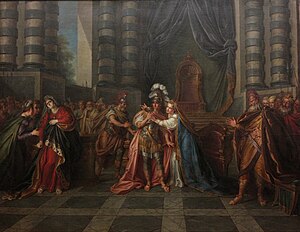Rhodogune of Parthia
| Rhodogune | |
|---|---|
 Anachronistic painting of Rhodogune with Cleopatra II of Egypt by the 18th-century French painter Charles-Antoine Coypel. The Seleucid ruler Antiochus VIII Grypus is to the far right. | |
| Spouse | Demetrius II Nicator |
| Dynasty | Arsacid |
| Father | Mithridates I |
| Religion | Zoroastrianism |
Rhodogune (Ancient Greek: Ῥοδογούνη; 2nd century BCE) was a queen of the Seleucid Empire by marriage to Demetrius II Nicator. She was the daughter of the Parthian king Mithridates I (171-132 BCE), and sister of Phraates II (ruled 132-127 BCE).[1]
Life
In 138 BCE Rhodogune married Seleucid King Demetrius II Nicator (ruled 146-139 BCE, 129-126 BCE). They were kept by her brother in Hyrcania on the shores of the Caspian Sea, during which time they had several children.[2] During their marriage, Demetrius was temporarily a hostage in the Parthian court after an ill-fated campaign in Babylonia.[3]
Polyaenus[4] wrote that Rhodogune, informed of a revolt while preparing for a bath, vowed not to bathe or brush her hair until the revolt was quashed. She immediately went into battle, riding out to the head of her army. She defeated the rebels, and was depicted thereafter on seals of the kings of Persia with long, disheveled hair because of her adherence to her vow. This incident is also mentioned in the anonymously written Tractatus de mulieribus, which elaborates further on the story, describing her as being depicted with a golden statue showing her hair half-braided, half unbraided.[5]
She was presumably abandoned in 129 BCE when Demetrius, after numerous failed attempts to escape from Parthia, was dispatched back to Antioch during the invasion of Parthia by Demetrius's brother, Antiochus VII Sidetes.
References
- ^ Assar, A Revised Parthian Chronology of the Period, 165-91 BCE, 2006. pg 88-112.
- ^ Overtoom, N.L. Reign of Arrows: The Rise of the Parthian Empire in the Hellenistic Middle East, 2020. pg. 40, 184, 196-97.
- ^ Overtoom, N.L. Reign of Arrows: The Rise of the Parthian Empire in the Hellenistic Middle East, 2020. pg. 176-88.
- ^ (8.27)
- ^ Gera, Deborah Levine. Warrior Women: The Anonymous Tractatus De Mulieribus, p.8
Sources
- Schmitt, Rüdiger (2017). "Rhodogune". Encyclopaedia Iranica.
